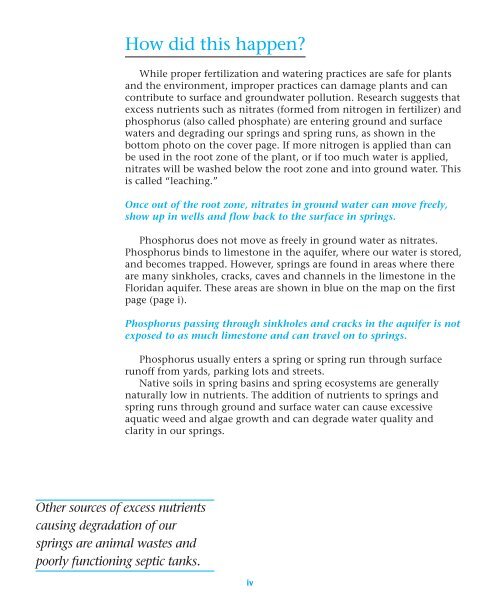What You Need to Know About Fertilizing and Watering - Southwest ...
What You Need to Know About Fertilizing and Watering - Southwest ...
What You Need to Know About Fertilizing and Watering - Southwest ...
You also want an ePaper? Increase the reach of your titles
YUMPU automatically turns print PDFs into web optimized ePapers that Google loves.
How did this happen?<br />
While proper fertilization <strong>and</strong> watering practices are safe for plants<br />
<strong>and</strong> the environment, improper practices can damage plants <strong>and</strong> can<br />
contribute <strong>to</strong> surface <strong>and</strong> groundwater pollution. Research suggests that<br />
excess nutrients such as nitrates (formed from nitrogen in fertilizer) <strong>and</strong><br />
phosphorus (also called phosphate) are entering ground <strong>and</strong> surface<br />
waters <strong>and</strong> degrading our springs <strong>and</strong> spring runs, as shown in the<br />
bot<strong>to</strong>m pho<strong>to</strong> on the cover page. If more nitrogen is applied than can<br />
be used in the root zone of the plant, or if <strong>to</strong>o much water is applied,<br />
nitrates will be washed below the root zone <strong>and</strong> in<strong>to</strong> ground water. This<br />
is called “leaching.”<br />
Once out of the root zone, nitrates in ground water can move freely,<br />
show up in wells <strong>and</strong> flow back <strong>to</strong> the surface in springs.<br />
Phosphorus does not move as freely in ground water as nitrates.<br />
Phosphorus binds <strong>to</strong> limes<strong>to</strong>ne in the aquifer, where our water is s<strong>to</strong>red,<br />
<strong>and</strong> becomes trapped. However, springs are found in areas where there<br />
are many sinkholes, cracks, caves <strong>and</strong> channels in the limes<strong>to</strong>ne in the<br />
Floridan aquifer. These areas are shown in blue on the map on the first<br />
page (page i).<br />
Phosphorus passing through sinkholes <strong>and</strong> cracks in the aquifer is not<br />
exposed <strong>to</strong> as much limes<strong>to</strong>ne <strong>and</strong> can travel on <strong>to</strong> springs.<br />
Phosphorus usually enters a spring or spring run through surface<br />
runoff from yards, parking lots <strong>and</strong> streets.<br />
Native soils in spring basins <strong>and</strong> spring ecosystems are generally<br />
naturally low in nutrients. The addition of nutrients <strong>to</strong> springs <strong>and</strong><br />
spring runs through ground <strong>and</strong> surface water can cause excessive<br />
aquatic weed <strong>and</strong> algae growth <strong>and</strong> can degrade water quality <strong>and</strong><br />
clarity in our springs.<br />
Other sources of excess nutrients<br />
causing degradation of our<br />
springs are animal wastes <strong>and</strong><br />
poorly functioning septic tanks.<br />
iv
















